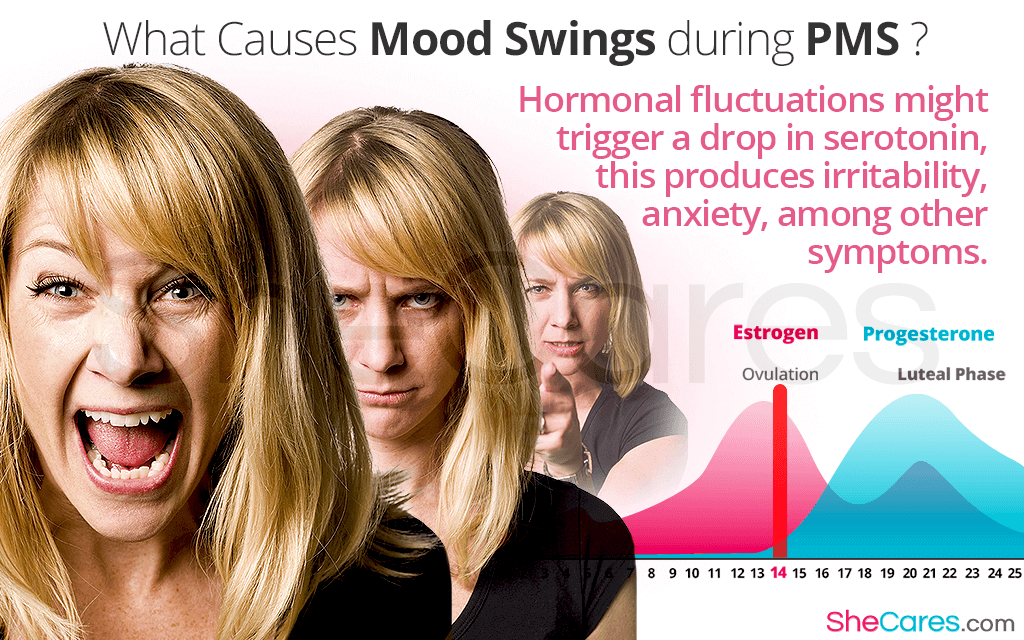The symptoms of premenstrual syndrome (PMS), such as mood swings, are reported by nearly 80% of women. They vary in their severity and effects, but many women complain that a monthly emotional turmoil disrupts their relationships and prevents them from functioning at the best potential. Fortunately, there are effective ways to manage premenstrual mood swings. Continue reading to learn more about what period mood swings are, what causes them, and how you can manage them.
What Is PMS ?
Premenstrual syndrome (PMS) can occur in the last phase of the menstrual cycle, called luteal, a week or two before the start of an actual period. Not all women experience PMS, but those that do may suffer from a series of uncontrollable mood changes among other symptoms. They can include sudden tantrums of anger and irritability, followed by unstoppable crying spells and despair, all within a short period of time. Mood swings typically stop a day or two after the menstruation begins.
What Causes Mood Swings during PMS?
PMS is believed to be caused by hormonal changes, although science does not yet understand the exact mechanism behind it. During the luteal phase, levels of estrogen and progesterone, the key hormones in the menstrual cycle, shift drastically.
Studies have shown that these fluctuations might trigger a drop in serotonin, which is a neurotransmitter and a natural mood stabilizer. Low serotonin is associated with irritability and aggression, anxiety, feeling overwhelmed, and other depression-like symptoms. Once the period begins, estrogen and progesterone stabilize and the mood swings resolve right away.
How to Manage Mood Swings during PMS?
Every women experiences her menstruation differently, so it is important to take the time and customize your own management plan to cope with menstrual mood swings. PMS mood swings can be managed with:
Hormone stabilizers
There are various natural substances that can stabilize moods and reduce the severity of PMS. They include hormone-regulating supplements and phytoestrogens, such as chasteberry and black cohosh.
Severe mood swings during PMS are sometimes treated with anti-depressants, oral contraceptives, or other hormonal treatments, but they are not appropriate for all women. Progesterone cream applied to skin before the period starts can reportedly alleviate the PMS symptoms, as well.
Natural remedies
Supplements of vitamin E and D, magnesium, and Omega-3 fatty acids have shown to reduce the symptoms of PMS. Acupuncture is also reported to improve pre-menstrual mood, promoting happier and more balanced states.
Some women find mood relief in mild exercises, such as yoga or Pilates, due to a boost of endorphins, dopamine, and serotonin they triggers. Limiting sugar and caffeine intake might also lessen the mood fluctuations.
When Should I Be Worried?
Premenstrual mood swings are difficult to deal with and often cause a great deal of disturbance in women's life, but generally they are not dangerous. If, however, these mood shifts become too overwhelming and nearly impossible to manage, it might be an indication that you suffer from the premenstrual dysphoric disorder (PMDD).
PMDD is a severe form of PMS, which can cause women to become deeply depressed for a week or two before their period begins, often with suicidal thoughts. You should always talk to your doctor if you have difficulty coping with your PMS, especially if you are in danger of hurting yourself.
Menstruation, though often unpleasant and hated by women, is a natural part of every woman's life. However, when the premenstrual syndrome and mood swings start to compromise the way you feel and function, they should be adequately handled. Ask your doctor for help, if the symptoms you experience are too overwhelming for you. You might also want to learn more about ways to manage your PMS naturally.
